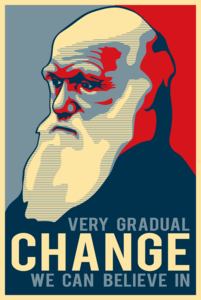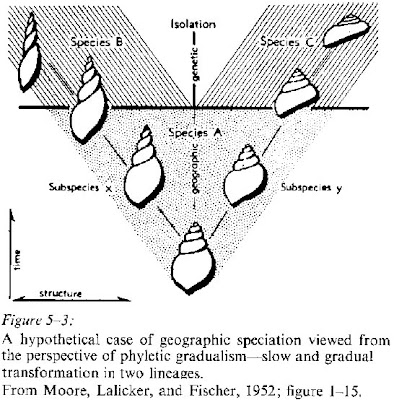
Most people do not understand current ideas about evolution. The following is a brief summary of the Modern Synthesis of Genetics and Evolution as put forth by evolutionary biologists in the late 1940s.
The idea that life on Earth has evolved was widely discussed in Europe in the late 1700s and the early part of the 1800s. In 1859 Charles Darwin supplied a mechanism—namely natural selection—that could explain how evolution occurred. Darwin's theory of natural selection helped to convince most people that life has evolved and this point has not been seriously challenged in the past one hundred and fifty years.
It is important to note that Darwin's book
The Origin of Species by Means of Natural Selection did two things. It summarized all of the evidence in favor of the idea that organisms have descended with modification from a common ancestor. Darwin built a strong case for evolution. In addition, Darwin advocated natural selection as a mechanism of evolution.
Biologists no longer question whether evolution has occurred or is occurring. That part of Darwin's book is now considered to be so overwhelmingly demonstrated that is is often referred to as the FACT of evolution. However, the MECHANISM of evolution is still debated [
Evolution Is a Fact and a Theory].
During the first part of this century the incorporation of genetics and population genetics into studies of evolution led to a Neo-Darwinian theory of evolution that recognized the importance of mutation and variation within a population. Natural selection then became a process that altered the frequency of genes in a population and this came to be the minimal definition evolution [
What Is Evolution?].
The earliest version of this essay appears on the TalkOrigins Archive.
A later version is at Evolution by Accident.This point of view held sway for many decades but by the 1940s the classic Neo-Darwinian view was replaced by a new concept that brought together field biology, paleontology, and population genetics. The new version took pains to exclude all mechanisms except natural selection and random genetic drift. This new version was called
The Modern Synthesis after the title of a 1942 book by Julian Huxley.
We have learned much since Darwin's time and it is no longer appropriate to claim that natural selection is the only mechanism of evolution. I can understand why this point may not be appreciated by the average non-scientist because natural selection is easy to understand at a superficial level. It has been widely promoted in the popular press and the image of "survival of the fittest" is too powerful and too convenient.
One of the goals of the Modern Synthesis was to reach consensus on the importance of macroevolution. The founders of the Modern Synthesis insisted that macroevolution could be explained by microevolution and no additional mechanisms—such as the bogeyman of saltation—were required.
Ernst Mayr, one of the original founders of the Modern Synthesis, sums it up this way ...
The term "evolutionary synthesis" was introduced by Julian Huxley in Evolution: The Modern Synthesis (1942) to designate the general acceptance of two conclusions: gradual evolution can be explained in terms of small genetic changes ("mutations") and recombination, and the ordering of the genetic variation by natural selection; and the observed evolutionary phenomena, particularly macroevolutonary processes and speciation, can be explained in a manner that is consistent with the known genetic mechanisms.
Ernst Mayr (1980) "Some Thoughts on the History
of the Evolutionary Synthesis" in The Evolutionary Synthesis,
E. Mayr & W.B. Provine eds. Harvard University Press.
The original version of the Modern Synthesis included mechanisms other than natural selection, especially random genetic drift. Later on, there was a hardening of the synthesis so that natural selection became the predominant mechanism and drift was relegated to a bit part (see Mayr quotation, above). The original version is described by Douglas Futuyma as ....
The major tenets of the evolutionary synthesis, then, were that populations contain genetic variation that arises by random (ie. not adaptively directed) mutation and recombination; that populations evolve by changes in gene frequency brought about by random genetic drift, gene flow, and especially natural selection; that most adaptive genetic variants have individually slight phenotypic effects so that phenotypic changes are gradual (although some alleles with discrete effects may be advantageous, as in certain color polymorphisms); that diversification comes about by speciation, which normally entails the gradual evolution of reproductive isolation among populations; and that these processes, continued for sufficiently long, give rise to changes of such great magnitude as to warrant the designation of higher taxonomic levels (genera, families, and so forth).
Futuyma, D.J. in Evolutionary Biology,
Sinauer Associates, 1986; p.12
This description would be incomprehensible to Darwin since he was unaware of genes and genetic drift. The Modern Synthesis differed from Darwinism in four important ways:
- It defined evolution as a change in the frequency of alleles in a population; an idea based on population genetics.
- In addition to natural selection, it recognized random genetic drift as an important mechanism of evolution.
- It recognized that characteristics are inherited as discrete entities called genes. Variation within a population is due to the presence of multiple alleles of a gene. Variation is caused by mutation.
- It postulated that speciation is (usually) due to the gradual accumulation of small genetic changes. This is equivalent to saying that macroevolution is simply a lot of microevolution.
The Modern Synthesis was a theory about how evolution worked at the level of genes, phenotypes, and populations whereas Darwinism was concerned mainly with organisms, speciation and individuals. This was a major shift in emphasis and those who fail to appreciate it find themselves out of step with the thinking of evolutionary biologists.
The major controversies among evolutionary biologists today concern the validity of points #2 and #4 (above).
Following the centennial celebrations of the publication of
Origin in 1959, there was a gradual hardening of the Modern Synthesis. The 1960s version concentrated almost exclusively on natural selection as a mechanism and random genetic drift was pretty much ignored. Today, there is debate about the relative importance of these two mechanisms and some are calling for an updating of the "hardened" Modern Synthesis.
This update would restore random genetic drift as an important mechanism, recognize neutral theory, and incorporate molecular phylogeny (and the molecular clock).
There are many who believe that the fossil record does not show gradual change but instead long periods of stasis followed by rapid speciation. This model is referred to as Punctuated Equilibrium and it is widely accepted as true, at least in some cases. The debate is over the relative contributions of gradual versus punctuated change, the average size of the punctuations, and the mechanism.
The Modern Synthesis is challenged over the emphasis on gradualism and over the claim that microevolution is sufficient to explain macroevolution. Some evolutionary biologists suggest that evolutionary theory be modified to incorporate mechanisms that occur at levels higher than the population (e.g. species sorting). These scientists advocate an extension called hierarchical theory.
There are other challenges to the Modern Synthesis. Some of them are valid and some of them are silly. But I think it's fair to say that the 50-year old version needs
some serious updating to incorporate
some of the new concepts.
Some scientists continue to refer to modern evolutionary theory as Neo-Darwinian. In some cases these scientists do not understand that the field has changed but in other cases they are referring to what I have called the Modern Synthesis, only they have retained an old name from the early 1900s.

 I don't look good in T-shirts but there's plenty of other gifts for me on that site. All those shoppers who might be looking to buy me something for St. Patrick's day should check out the large mugs.
I don't look good in T-shirts but there's plenty of other gifts for me on that site. All those shoppers who might be looking to buy me something for St. Patrick's day should check out the large mugs.



























